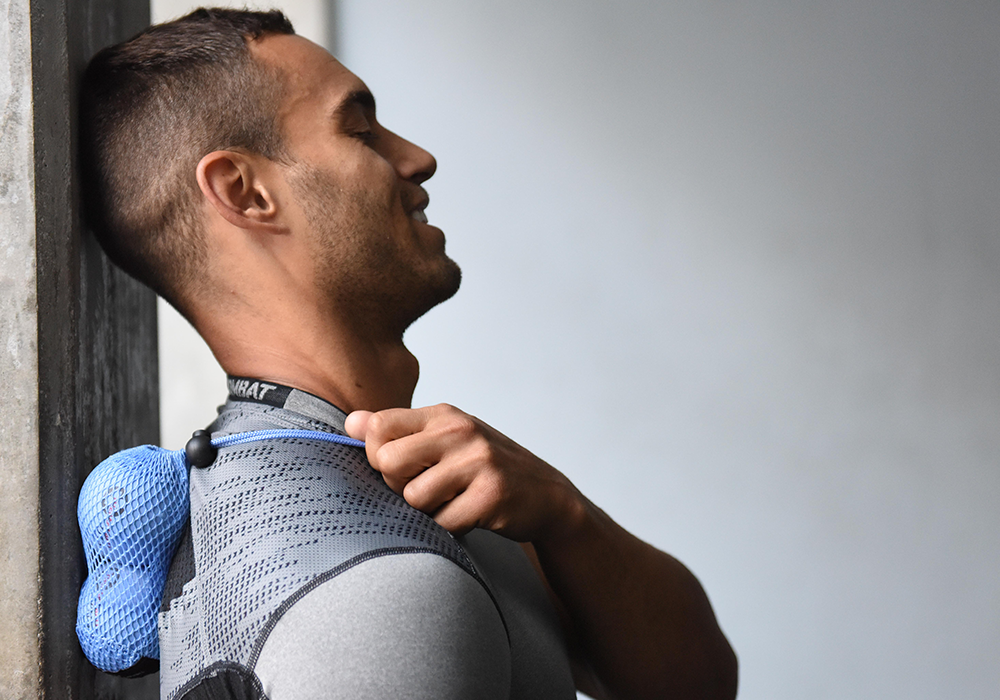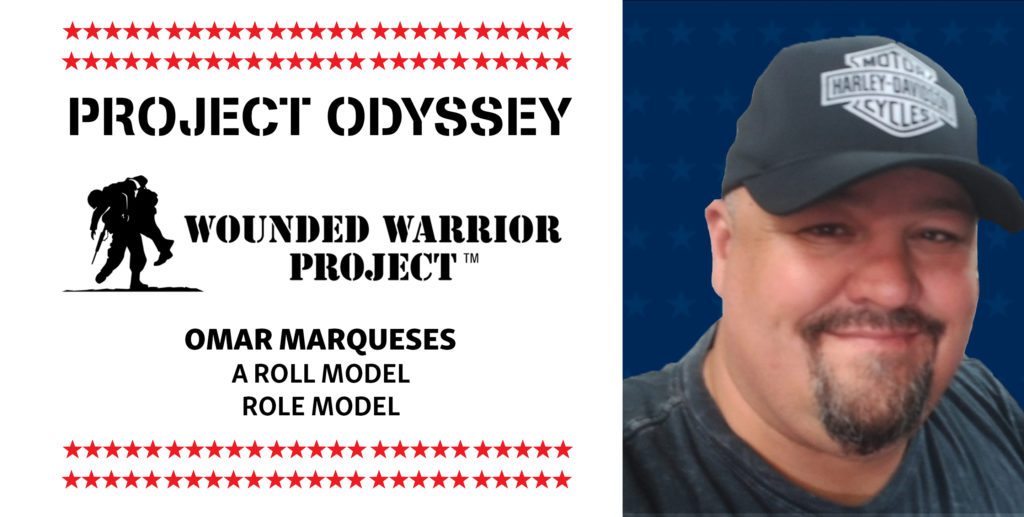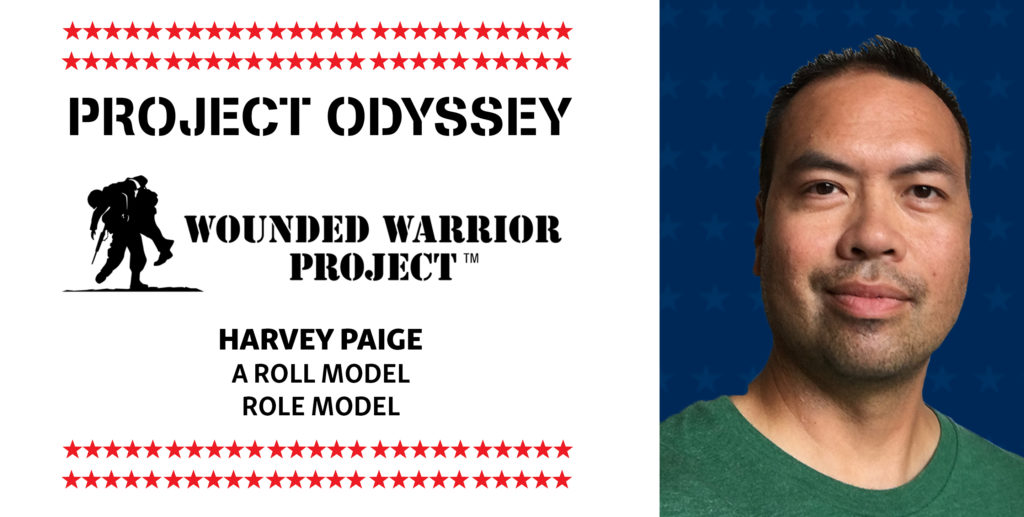
In Part I of our Wounded Warrior Project Series, we interviewed US Army Veterans Harvey Paige and Texas Army National Guard Omar Marqueses about their military experience and how Project Odyssey (Wounded Warrior Project’s retreat program for combat veterans) and a pair of therapy balls changed their lives. Below are more of their stories.
Paige, 39, lives in Louisiana with his wife and two boys, 10 and 12.
TUF: First off, thank you for your service and for everything you’ve done for our country. Can you tell me about your military background? When and where did you serve?
HP: I served in the Army from 2001 through 2010 and during that time was deployed in Afghanistan and Iraq multiple times. I was wounded several times, but the injury that retired me was from an IED that hit me right below my knee and fractured the bone. They tried to put in screws and a plate to repair it, but it never went back to normal and it inhibits me from running.
TUF: What motivated you to participate in Project Odyssey?
HP: Honestly, my wife. She thought it would be good for me to connect with other veterans who are dealing with the same issues I’ve dealt with. And she was right! I’ve been on three Odysseys since.
TUF: Can you tell me about your first encounter with the Roll Model® Therapy Balls?
HP: (Laughs) Yeah, there were nine of us guys—all Army and Marines—and Greg (Project Odyssey leader, Combat Stress Recovery Specialist and certified Roll Model® Method Practitioner Greg Hancock) brought out these balls. Of course, we all made jokes about them. But then he showed us how to massage our feet, calves, quads and back, and how to get under our glutes. He showed us how to breathe and focus and ground ourselves. I actually made “using the balls” one of my Smart Goals, which we set before leaving Project Odyssey. These are goals we hold ourselves accountable for, for 90 days before checking in with our Odyssey leader.
TUF: How have the Roll Model® Therapy Balls helped you?
HP: Well, I keep one set at work and I use them mostly as a mindset thing. I get amped up pretty easily. If I’m having a rough time, I’ll pull them out and lean up against a wall and dig into my shoulders, or sit on the floor with one under my leg. Or even just work my hand over a ball. It eases my muscles, but also it takes me out of my funk. It takes me back to another mindset—where I’ll be like, “What was I really so mad about?”
TUF: Sounds like the Therapy Balls have had some great mental benefits, have they been helpful for you physically?
HP: Yes, the second set I keep at home and use after workouts. They really help my muscles recover faster after working out and help with mobility. My favorite thing to do is put them right behind my shoulder blades, on a wall or on the floor. I love the pressure.
TUF: Thank you for sharing this piece of your journey with us. Is there anything else you’d like to share about your experience with Project Odyssey or working with the Therapy Balls?
HP: Before I went on Project Odyssey, I was in a weird place. I lost a lot of guys over there. It was expected that we wouldn’t make it. Then I would think, “Why did I make it and they didn’t?” I felt selfish that they died and I was still here. From going on Odysseys and using the [Roll Model® Therapy] balls, I’ve gotten to appreciate what I did and be grateful for what I have. I still deal with struggles but I don’t want it to define who I am. I do what I can to make a difference, whether with helping fellow veterans or with my kids.
A Soldier—and Dad’s—Secret Weapon
Omar Marqueses has been serving his country for 22 years as a member of the Texas Army National Guard. Marqueses, 40, considers himself lucky that he hasn’t suffered any major injuries, but he’s had his share of pain—including back pain due to an inflamed disc since 2004 and plantar fasciitis in both feet that started in 2009.

Project Odyssey leader Greg Hancock introduced the Roll Model® Therapy Balls to Marqueses’ group and invited them all to roll out the bottoms of their feet. Marqueses immediately felt a difference, not just in his decreased level of pain but also his improved flexibility. Working with Hancock, Marqueses and his fellow warriors also learned to use the balls for other areas of their body, including the hips, back, temples, and jaw (headaches and jaw clenching go hand-in-hand with post-traumatic stress, so these are common problem areas for combat veterans).
“I’ve tried getting massages in the past, but they are so expensive. The Roll Model® Therapy Balls are a great alternative—not only are they inexpensive, but they are so much more convenient. And they really help me get to deeper knots in my muscles than a foam roller does.” When Marqueses used to get out of bed in the morning, those first few steps hurt so bad that he had to grab on his son’s crib rail to lessen the pain from his feet. Now he uses the Roll Model® Therapy Balls every morning. “If I loosen up the bottoms of my feet first, it really does so much to alleviate that pain.”
Below are two of Marqueses’ favorite ways to use the Roll Model® Therapy Balls.
Exercise #1 – Bottoms of feet: Arch cross
- Stand next to a chair or wall and place a hand on it to help you balance. Step your left arch on top of a Roll Model® Therapy Balls (Original YTU or PLUS) so that it nestles into the center of your arch. Keep your heel on the ground.
- Take 5 to 10 abdominal breaths, allowing your foot to enrobe the ball.
- Next, CrossFiber your arch and plantar fascia by pivoting your ankle from side to side (invert and evert your ankle) 10 times. Attempt to smush the ball as you go back and forth.
Exercise #2 – Upper back: Unzip the Bony Corset
- Place the Original YTU or PLUS balls on either side of your spine, just below C-7, and press your back up against a wall.
- Bend and straighten your knees to create a small push-pull motion that drags the balls and strips up and down your back in an approximately 2- to 3-inch range.
- Lean your body more deeply into the left ball for a few strokes, then deeper into the right ball for a few strokes.
Note: You can also do this move lying on your back, lifting your hips off the ground and using the pressure of your feet to move the balls.
For more on how The Roll Model® Method and Project Odyssey are helping combat veterans, read Wounded Warrior’s ‘Project Odyssey’ Gets Their Roll on for Recovery.












What an amazing project. It’s great that veterans have this as an opportunity to connect with each other. Also, it’s amazing that they can learn skills to manage pain and injury that puts them in control through knowledge and self-application.
Certainly, YTU balls are for everyone, but this is a reminder that those going through trauma can doubly benefit from these therapeutic balls. The physical component of releasing tension in the body is understood by most, but it good to get a reminder of how these therapy balls can also help one manage their emotions. Throughout my life, I have always valued how much movement and activity have helped me to manage emotions, I now have another tool in the YTU balls!
I loved reading about how these YTU Balls have been so helpful to Veterans. What a great way to help these folks who have served their country! It would be interesting to hear more about what, if any, other emotional or psychological release the self-massage therapy has encouraged.
My husband was in the Army and National Guard for 10 years, and served a year in Iraq early in the war. The way he talks about the army includes so much taught disembodiment– you have to rush through eating your food, you have to rush through brushing your teeth, you either have too little or too much time to sleep, you’re out in extreme cold or extreme heat for long amounts of time. Whether that approach is necessary for military effectiveness or not is a separate question. But I hope as many veterans and soldiers as possible can have access to the roll model techniques for embodiment and nervous system down regulation.
Again, very inspiring to see the reach of this very important work. Thank you for sharing these individual’s stories and the positive impact that the Roll Model® Therapy Balls has had in their lives. I look forward to learning and hearing more about YTU therapy!
What a great example of the diversity of the use of the Therapy balls to affect change. Taking a moment to roll to get in touch with your feelings is very powerful as Harvey Paige, the first veteran in your story, refers to. It’s like a time out with the added benefit of releasing body tension and re-aligning to a healthier mind set. I can relate to the jaw clenching and headaches from PTSD and once again, the Therapy Balls help me, on a daily basis, to stay tuned into my mindbody state.
Wow, this was a really powerful and interesting read. Thank for sharing your stories, it’s so inspiring to see how many people YTU can reach and help.
I have worked with Veterans in a few different capacities including yoga, meditation and pet therapy and found it immensely rewarding to be able to help and see great improvements! This will add another way to provide for this and similar communities, which I will be glad to apply and share! Thank you so much!!
Great article! My fabulous nephew is in the Marines, and he is getting a set of Roll Model Therapy Balls and this info for his birthday. Thanks!
This story really inspired me! I’m quite new to YTU but I’m here in the hopes of being able to help people with their various tensions and injuries. This just opened my eyes to other groups/communities that could benefit from YTU classes and instruction. Thanks for the post!
Nicole, it is very powerful to hear these stories of restorative success for tension relief and deregulation- I like the connection between using the thearpy balls to propreocieve where my body is in space to allow for some deregulation
We work with a handful of veterans in our studio and I plan on sharing some of these amazing benefits with our community. Very inspiring! Thanks for sharing!